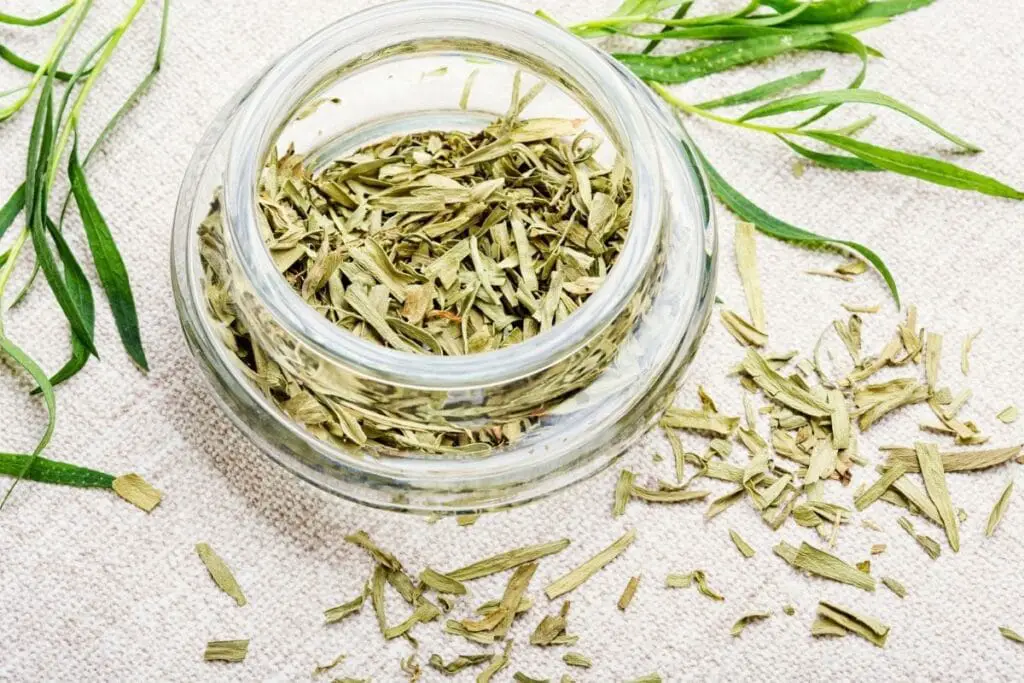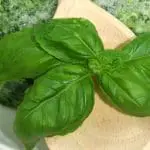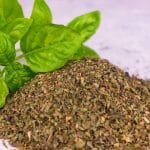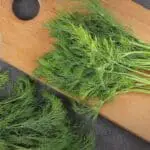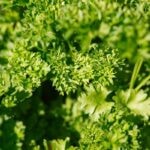In short, the best alternatives to tarragon include dried tarragon, fennel fronds, chervil, fennel seeds, basil, anise seeds, etc. I will explain how to use and how much to use below. These substitutes offer various flavors and dietary options, making them suitable for different preferences.
Although used in a variety of cuisines, tarragon is popularly known for its inclusion in French béarnaise sauce and pairs well with fish, eggs, salads, and chicken dishes. It can also be used to make salad dressings, oils for roasting vegetables, sauces, aioli, and pesto.
If your recipe calls for tarragon herb and there’s none in the pantry, don’t just leave it out but opt for a suitable replacement instead. In this guide, we’ll help you pick the perfect tarragon substitute for your dish.
Whether you’re making a sauce, soup, chicken, or salad, there are many options, but you have to pick carefully. Here are our top tips for choosing the best substitute for tarragon.
What is Tarragon?
Tarragon is a herb with elongated green leaves and thin woody stems. Only the leaves are used and can be incorporated freshly chopped or whole into salads, potato dishes, and meaty meals. It is also available in a dried herb form.
The leaves have a distinct licorice flavor. However, the variety of tarragon you use may influence how strong the licorice accents are. French tarragon is the most commonly used type.
Despite the mild anise flavor, it features a unique bitter-sweet complexity with hints of mint, pepper, vanilla, and eucalyptus. This makes it more nuanced than bolder licorice herbs such as fennel.
Russian tarragon has a stronger flavor with a slightly bitter taste, while Mexican tarragon (also called Spanish tarragon) has a similar yet slightly richer taste to the French variety.
Which is Better: Fresh or Dried Tarragon?
Tarragon is a delicate herb that loses a lot of its unique subtle accents once dried. To get the best flavor and fine nuances, using fresh tarragon leaves are recommended. Due to the significant difference between fresh and dried tarragon, many chefs won’t use the dried version.
When using the herb fresh, rinse the leaves and remove them from the stem. They can be used whole or chopped and are best used raw. If they’re being used in a cooked dish, only add them in at the end of the cooking time since prolonged exposure to heat will dull the flavor.
The dried version, on the other hand, can be added early on and used in cooked dishes or dressings but does not have the same distinct tarragon taste as the fresh leaves.
Substitution tip: For the best results, always replace fresh tarragon with fresh herbs and dried herbs when your recipe requires dried tarragon.
If you don’t have a suitable alternative in the right form, use fresh and dry herbs interchangeably as the second-best option but keep in mind that you should use less of the dried version when replacing fresh leaves. As a general rule, use one teaspoon of dried herbs to replace a tablespoon of fresh tarragon.
Best Replacement for Tarragon
#1. Dried Tarragon
If you don’t have fresh leaves but have dried herbs in your spice rack, use them instead. This won’t be suitable in recipes that require the use of fresh leaves for a green salad but is definitely suitable for dressings and cooked dishes.
It won’t necessarily offer the same pop of flavor but will successfully add some of the accents that you are after.
Quantity: Use one teaspoon of the dried herb to replace a tablespoon of the fresh version.
Best for: Salad dressings, flavored pickling vinegar, sauces, chicken, fish, potato or egg dishes, and baked goods.
#2. Fennel Fronds
Fresh fennel leaves, or fennel fronds, have a similar licorice pop, so if this is not something you’re trying to avoid, this is a great tarragon alternative.
Although the bulbous vegetable part of fennel is not suitable as a herb replacement in most dishes, it can be shaved thinly into salads to add the same pronounced licorice taste. It is crunchy, so it will also bring texture to your dish.
For most other uses, the fronds that grow out from the bulb will make a good tarragon leaves substitute.
Quantity: Substitute in equal quantities.
Best for: Citrus salads, garnishing, dressings, light soups, potato, and green salads, as well as other dishes with uncomplicated flavor profiles.
See more: Fennel bulb substitute
#3. Chervil
Chervil is part of the parsley family, with leaves shaped similar to carrot greens or flat-leaf parsley. The flavor is reminiscent of fresh parsley with soft notes of licorice.
It is also commonly used in French recipes and has a delicate, subtle taste. This means it is best used in raw, light dishes to prevent it from diminishing with exposure to heat or getting lost behind bolder flavors.
Quantity: Start with the same amount as required in your recipe and then add more to taste if needed.
Best for: Garnishing salads, clear soups, eggs, and potatoes. It is also suitable for stuffing chicken and fish, dressings, and dips.
#4. Fennel Seeds
Dried fennel seeds have powerful licorice or anise taste which makes them great for adding to cooked recipes with bold flavors. The small oval-shaped seeds have a green/gray color and slight sweetness to them.
Although they don’t look at all like tarragon, they’ll bring a similar taste sensation if used sparingly. You can use them whole or ground. If you are using the seeds whole, use a mortar and pestle to crack them lightly to release some of the flavors.
Keep in mind that these seeds have a much stronger flavor, so you will only need a small amount.
Quantity: Use only an eighth of a teaspoon to substitute a tablespoon of tarragon.
Best for: Dressings, fish dishes, sausage recipes, and baked goods.
#5. Basil
Fresh basil leaves are generally easy to find and have hints of anise, pepper, and mint. The flavor profile is not quite the same as tarragon, but it will bring some of the same herbal nuances that would otherwise be missing.
Using Thai basil is also an option and may even give you stronger licorice accents than Genovese basil.
Quantity: If you are using fresh basil in salads, start with equal quantities. Add more if you feel the dish requires further herbal intensity.
When using dried basil as a dried tarragon substitute, use one teaspoon to replace a tablespoon of fresh herbs.
Best for: Salads (fresh leaves), dressings, pasta, pizza, egg, and poultry dishes.
#6. Anise Seeds
Fennel seed and anise seed are often confused since they have a very similar appearance. Anise seeds are a great option when you don’t need a fresh herb but require the licorice flavor of tarragon in your dish.
The seeds stand up well to heat and can be used whole or as a ground powder. When using the seeds whole, toast them lightly before cooking to release some of the aromatic oils that will enhance the flavor.
Quantity: Since it is fairly potent, use only an eighth of a teaspoon to substitute a full tablespoon of herbs.
Best for: Cooked dishes including braised meat, soup, stew, and sauces.
#7. Dill
Fresh dill is a great choice for its visual appeal as a garnish. It has a bold fragrant flavor, although not exactly the same as tarragon, with bright feathery leaves.
If matching the flavor is as important as the visual vibrance, pair it with Thai basil or chervil. The seeds can also be used in a similar way to fennel seeds, either whole or crushed. However, this is not suitable as a garnish but more for adding flavor.
Quantity: When using the leaves, substitute them in equal quantities. When using the seeds, use a significantly smaller amount.
Best for: Adding flavor to stews and soups, sauces, dips, and as a garnish for potato salad, green salad, and seafood dishes. The seeds can be used in baked products, pickles, dressings, and vegetable dishes.
See more: Dry dill substitute
#8. Marjoram
Marjoram has a similar appearance to oregano, but the flavor is much sweeter and mild, and it has floral pine and citrus accents. It doesn’t have a licorice taste, so if you don’t like licorice, this could be a good tarragon replacement.
The small fresh leaves are sometimes hard to find, but the dried version can also be used to add a complexity of flavor to your dish.
Quantity: Substitute the fresh herb in equal quantities.
If your recipe calls for fresh herbs and you are using dried marjoram, use one teaspoon for every tablespoon required.
If you are replacing dried marjoram for dried tarragon, substitute it in equal quantities.
Best for: Meaty dishes, seasonings for turkey, chicken, and vegetables.
Related: Marjoram substitute
#9. Herbes de Provence
This blend is suitable when you need to replace dried herbs in your dish. The French herb blend typically includes basil, thyme, marjoram, and rosemary. However, some brands might also include tarragon, parsley, or chervil.
The herb blend offers a great herbaceous depth for French cuisine and (depending on the composition of the blend you have) can also bring a touch of anise-like flavor.
Quantity: Substitute in equal quantities for dried herbs.
Best for: Eggs and omelets, roast chicken, potato, and other vegetable dishes. This versatile blend can be added to a variety of French-inspired recipes.
#10. Fines Herbes
Another French herb blend, this one, constitutes parsley, chervil, tarragon, and chives. It can be used fresh or dried. Just remember that the dried herbs are more intense than the fresh ones.
Quantity: Substitute the fresh herbs in equal quantities.
If your recipe calls for fresh herbs and you are using a dried blend, use one teaspoon for every tablespoon required.
If you are replacing dried Fines Herbes for dried tarragon, substitute it in equal quantities.
Best for: Delicate dishes like fish, eggs, and chicken. The fresh herbs can also be used as a garnish.
#11. Rosemary
Rosemary is an easy find that is generally available in its dried and fresh versions. It has needle-like leaves on a woody stem.
Rosemary has a distinct aromatic peppery pine taste that is different from tarragon. However, it is also popular in French cooking and will bring some life to the party when tarragon isn’t around.
Since fresh rosemary leaves are quite hardy, they’re not suitable as a garnish, but they retain their flavor well even when dried. The dried version can be a little strong, so always taste when cooking so that your dish doesn’t end up with an overpowering rosemary punch.
Quantity: Use one teaspoon of dried rosemary to replace a tablespoon of fresh herbs.
Best for: Meat, chicken, vegetables, stews, and potatoes.
#12. Oregano
Oregano has a distinct association with pizza. It has deep savory notes and can add a lot of flavor to your recipe. It doesn’t have the same flavor profile as tarragon but will definitely boost your dish with remarkable complexity.
Dried oregano is also pretty easy to find which makes it an easy swap in cooked dishes.
Quantity: Since it has an intense flavor, use a smaller amount than called for in your recipe.
Best for: Tomato-centric pasta dishes, sauces, salad vinaigrettes, and stews. It is also ideal for meat, poultry, and vegetable dishes.
FAQ
Conclusion
Tarragon’s long bright pointy leaves make this herb great to use in various ways. Whether as a garnish, fresh in salads, or dried in dressings, stews, with fish and chicken, there is a whole world of cooking to explore with this licorice-flavored herb.
The only problem is that it is not always an easy herb to find. Whether your recipe calls for dried or fresh leaves, there are plenty of alternatives to choose from.
When choosing the best substitute, always consider what the herb needs to bring to the dish. Is it freshness, color, licorice flavor, or just an improved all-around complexity? Once you’ve determined this, you can easily pick a just-as-good alternative for your delicious recipe.
*image by PantherMediaSeller/depositphotos
